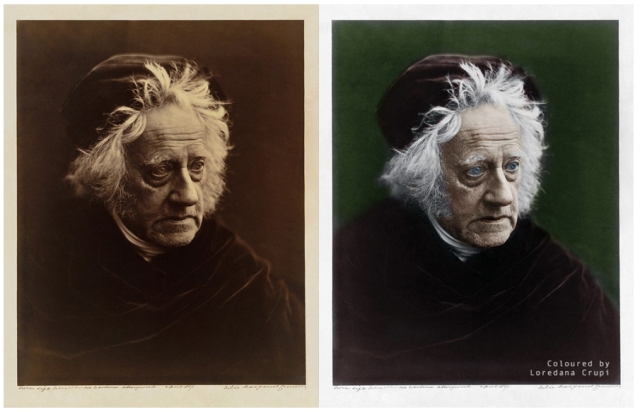Day 125 of Colourisation Project – September 9
Challenge: to publish daily a colourised photo that has some significance around the day of publication.
Today’s subject, Sir John Frederick William Herschel is believed to be the man who coined the term photography and who on this day September 9, 1839 took the first ever glass plate ‘photograph‘; an image of his father’s 40 foot telescope which to this day remains the oldest photograph on glass. (Daguerreotypes to that point were still on silver plates.)
Born in Berkshire, England in 1792, Herschel was a highly esteemed scientist, mathematician, astronomer, chemist, experimental photographer and botanist. His father was the noted astronomer William Herschel, who discovered the planet Uranus.

Photo: Julia Margaret Cameron – John Herschel 1867 – Restored by Adam Cuerden – Coloured by Loredana Crupi
Today’s colourisation is an Albumen silver print from glass negative taken by Julia Margaret Cameron in 1867. She used an unorthodox technique opting for carefully directed light, soft focus, and long exposures. Her portraits deviated from the standards of the time in that there were no classical columns, props or academic poses utilised in her images. As Cameron explains in her autobiography, Annals Of My Glass House (1874), she and Herschel were long standing friends of some thirty years and she viewed him as a mentor, a ‘Teacher and High Priest.’ It was that essence she wanted to capture in her image; ‘the greatness of the inner as well as the features of the outer man.’ She directed her subject so that his tousled hair which she made him wash, would catch the light, as would his eyes. She clad him in black and photographed him emerging from the darkness like some ancient oracle of wisdom.
~~~~~~~~~~~~~~~~~~~~~~~~~~~~~
Herschel made many important contributions to photochemistry and the development of photography, including the discovery in 1819 of a method to make images permanent by fixing them with silver salts that have been exposed to light. Herschel was also the first to apply the terms negative and positive to photography.
For Herschel, science and art were inextricably linked. Through scientific experimentation he was able to apply a scientific exploration to art. He invented the cyanotype process, the precursor of the modern blueprint process and he experimented with color reproduction and photosensitive emulsions of vegetable juices, called phytotypes. In 1942 his discoveries were published in the Philosophical Transactions of the Royal Society of London.
Herschel was the classic but modest polymath who somehow found the time to father 12 children; translate Homer’s Iliad; invent the actinometer, a tool which measures the direct heating power of the sun’s rays; instigate the Julian day system in astronomy; name seven moons of Saturn and four moons of Uranus; predict the use of microfilm and its use in storing public records; investigate colour blindness and the chemical power of ultraviolet rays; and publish a catalogue of his astronomical observations, the General Catalogue of Nebulae and Clusters, a compilation of his own work and that of his father’s. Herschel wrote many papers and articles, including A Treatise on Astronomy (1833) and entries on meteorology, physical geography and the telescope for the eighth edition of the Encyclopaedia Britannica.
Herschel died in 1871 at the age of 79 at his home in Collingwood, Kent. He was given a state funeral and buried in Westminster Abbey alongside the grave of Sir Isaac Newton.
______________________________________________________________
“A mind which has once imbibed a taste for scientific enquiry, and has learnt the habit of applying its principles readily to the cases which occur, has within itself an inexhaustible source of pure and exciting contemplations.” – John Frederick Herschel

Pingback: William Henry Fox Talbot – Pioneer Photographer | Random Phoughts